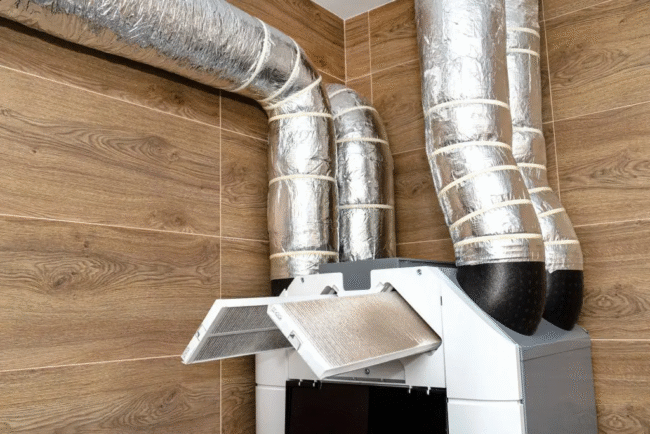
Let’s be honest—most of us don’t think about the air we breathe at home until something goes wrong. Maybe the bathroom mirror fogs up constantly, or the kitchen still smells like last night’s fish dinner. You open a window, crank up the heat, and wonder why your energy bills keep climbing higher each month.
But what if there was a smarter solution? One that could keep your home’s air fresh and clean while actually cutting your energy costs? That’s where MVHR units come in—a technology that’s quietly changing how we think about home ventilation.
An MVHR unit might sound complicated, but it’s actually solving a pretty simple problem: how to get fresh air into your home without wasting all the energy you’ve already spent heating or cooling it. These systems are becoming essential for anyone serious about creating a healthier, more efficient home.
What Exactly Is an MVHR Unit?
Think of an MVHR unit as your home’s respiratory system. It works around the clock, extracting stale, humid air from kitchens, bathrooms, and other spaces while bringing in fresh outdoor air. The clever part happens in the heat exchanger—a component that captures up to 95% of the heat from outgoing air and uses it to warm the incoming fresh air.
This isn’t just about comfort. It’s about efficiency that makes sense for your wallet and the environment.
The process works like this: stale air gets pulled out of your home through one set of ducts, while fresh air comes in through another. These two airstreams pass through the heat exchanger but never mix. The warmth transfers from one to the other, so you’re not losing all that expensive heated air when you ventilate your home.
For homeowners, this means:
- Fresh air without the energy penalty
- Consistent indoor temperatures
- Reduced strain on heating and cooling systems
- Better control over humidity levels
It’s elegant in its simplicity, really. Your home stays comfortable year-round while consuming significantly less energy than traditional ventilation methods.
Why Your Current Ventilation Approach Isn’t Working
Here’s something that might surprise you: indoor air can be 2-5 times more polluted than outdoor air. We spend about 90% of our time indoors, yet most homes rely on opening windows or basic exhaust fans for ventilation.
This creates a frustrating cycle. You open windows to get fresh air, which immediately starts changing your indoor temperature. Your heating or cooling system kicks in to compensate, burning through energy and money. Close the windows, and pollutants start building up again.
Poor ventilation creates several problems:
Moisture Issues: Excess humidity leads to condensation, mold growth, and that musty smell that’s so hard to eliminate. Traditional solutions often involve energy-hungry dehumidifiers or constantly running exhaust fans.
Pollutant Buildup: Cooking fumes, cleaning products, and even off-gassing from furniture accumulate without proper air exchange. Many homeowners resort to opening windows (wasting conditioned air) or using air purifiers that run continuously.
Temperature Swings: Opening windows for fresh air forces your HVAC system to work harder, leading to uncomfortable temperature fluctuations and higher energy bills.
Allergen Accumulation: Without proper filtration and air exchange, dust, pollen, and other allergens build up indoors, making life miserable for sensitive family members.
An MVHR unit addresses all these issues simultaneously. It’s like having a smart ventilation system that works 24/7 to keep your home healthy and efficient, without the constant battle between fresh air and energy costs.
The Real Impact on Your Energy Bills
Let’s talk about the numbers that actually matter—the ones on your monthly energy statements.
Traditional ventilation methods are incredibly wasteful. When you open a window during winter, you’re essentially throwing heated air outside and forcing your heating system to replace it. The same principle applies to air conditioning in summer. Your HVAC system works overtime to maintain comfortable temperatures while fighting against air loss.
MVHR units change this equation dramatically:
Heat Recovery Efficiency: Quality units recover 90-95% of heat from outgoing air. This means your heating system doesn’t have to work nearly as hard to maintain comfortable temperatures.
Reduced Heating Demand: Because incoming air is pre-warmed using heat that would otherwise be lost, your boiler or heat pump operates more efficiently. Many homeowners see heating cost reductions of 20-30%.
Consistent Performance: Unlike opening windows or using basic exhaust fans, MVHR units provide steady air exchange without temperature penalties. Your HVAC system can maintain set temperatures more easily.
Year-Round Benefits: These systems provide energy savings throughout the year by maintaining optimal indoor conditions without waste. Summer cooling costs drop too, since the system helps maintain consistent indoor temperatures.
The math is compelling. While the initial investment requires careful planning, most homeowners find that reduced energy costs pay for the system within 5-7 years. After that, it’s pure savings month after month.
Choosing the Right MVHR Unit for Your Home
Not all MVHR units deliver the same performance. When you’re investing in better air quality and energy efficiency, certain features become crucial:
Heat Recovery Rate: Look for units with efficiency ratings above 90%. This ensures maximum energy recovery and minimal waste. The difference between an 85% efficient unit and a 95% efficient unit adds up significantly over time.
Energy Consumption: The unit itself should be energy-efficient. Modern systems typically use just 20-40 watts—less than many light bulbs. Some older or poorly designed units can consume much more, undermining the energy savings.
Filter Quality: High-grade filters improve air quality while protecting the system’s efficiency. HEPA filters can remove 99.97% of particles, including allergens, dust, and pollutants. This means cleaner air and less maintenance for your HVAC system.
Noise Levels: Nobody wants a ventilation system that sounds like a jet engine. Quality units operate below 40 dB, ensuring quiet operation that won’t disrupt daily life or sleep.
Smart Controls: Advanced control systems optimize performance based on occupancy, humidity, and air quality sensors. This maximizes efficiency without sacrificing comfort, and some systems can even integrate with smart home platforms.
Installation and Integration Considerations
Installing an MVHR unit works best as part of a comprehensive approach to home efficiency. The system integrates beautifully with other energy-saving improvements:
Whole-House Approach: MVHR units work most effectively in homes with good insulation and air sealing. The investment in efficient ventilation pays bigger dividends when your home’s envelope is optimized.
Ductwork Design: Proper duct sizing and routing ensure optimal airflow and efficiency. Poor ductwork can significantly reduce system performance and increase energy consumption.
Zoned Ventilation: Advanced systems can provide different ventilation rates for different areas, optimizing energy use based on actual needs. Bedrooms might need different air exchange rates than kitchens or bathrooms.
Future-Proofing: Consider systems that can adapt to future home improvements or changes in occupancy. Modular designs offer flexibility as your needs evolve.
Working with installers who understand whole-house efficiency is crucial. They’ll ensure your MVHR unit complements your other investments rather than working against them.
Maintenance: Keeping Your Investment Running Smoothly
One of the appealing aspects of MVHR units is their relatively low maintenance requirements. Unlike complex systems that need constant attention, a well-installed unit runs reliably with basic care.
The maintenance routine is straightforward:
- Filter Changes: Replace or clean filters every 6-12 months, depending on air quality and usage. This is usually the most frequent maintenance task.
- Ductwork Inspection: Check for blockages, damage, or air leaks annually. Proper ductwork is essential for optimal performance.
- Professional Servicing: Annual tune-ups ensure optimal performance and catch potential issues early. This typically involves checking fan operation, cleaning heat exchangers, and verifying control settings.
- Sensor Calibration: If your system has humidity or air quality sensors, they may need periodic calibration to maintain accuracy.
This minimal maintenance requirement is part of what makes MVHR units so practical for busy homeowners. The time investment is small compared to the ongoing benefits.
Real-World Benefits Beyond Energy Savings
The advantages of MVHR units extend well beyond lower utility bills. These systems improve daily life in ways that reinforce their value:
Allergy Relief: Continuous filtered air helps family members with allergies breathe easier. Many homeowners find they need fewer medications and air purifiers after installing an MVHR system.
Mold Prevention: Controlled humidity levels prevent mold growth, eliminating the need for expensive remediation or harsh chemical treatments. This is especially valuable in bathrooms, basements, and other moisture-prone areas.
Improved Sleep: Better air quality and optimal humidity contribute to more restful sleep. Many users report sleeping better and feeling more refreshed.
Odor Control: Continuous air exchange eliminates cooking odors, pet smells, and other indoor pollutants naturally. Your home stays fresher without masking agents or air fresheners.
Reduced Dust: Better air filtration and circulation mean less dust accumulation on furniture and surfaces. This translates to less cleaning and better air quality for everyone.
These quality-of-life improvements make the investment feel worthwhile even before considering the energy savings.
Making the Financial Case
Investing in an MVHR unit requires upfront capital, but the long-term benefits make a compelling case:
Energy Savings: Reduced heating and cooling costs provide ongoing returns. The exact savings depend on your local climate, energy costs, and current home efficiency.
Increased Home Value: Homes with advanced ventilation systems often command higher resale values, especially as energy efficiency becomes more important to buyers.
Reduced Maintenance Costs: Better humidity control and air quality can extend the life of your HVAC system, flooring, and other home components.
Health Benefits: Improved air quality can reduce healthcare costs related to respiratory issues, allergies, and other air quality-related problems.
Available Incentives: Many regions offer rebates or tax incentives for energy-efficient home improvements, including MVHR systems. These can significantly reduce the net cost of installation.
Common Concerns and Real-World Solutions
Every technology has its challenges, and MVHR units are no exception. Understanding these upfront helps set realistic expectations:
Initial Cost: Yes, the upfront investment is significant. However, financing options and incentives can help manage the initial expense, and the long-term savings justify the investment for most homeowners.
Installation Complexity: Installing an MVHR unit isn’t a DIY project. It requires skilled professionals and careful planning. But this complexity ensures optimal performance and reliability.
Noise Concerns: Some homeowners worry about noise, but modern units are remarkably quiet. Proper installation and quality equipment minimize any sound issues.
Maintenance Requirements: While minimal, MVHR units do require regular filter changes and occasional professional service
